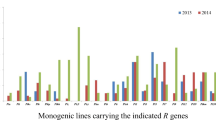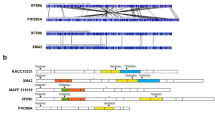Abstract
Rice blast, caused by Magnaporthe oryzae (M. oryzae), is one of the most destructive diseases in cultivated rice. The Wuling Mountain Area is marked as the key area for the national prevention and control of rice blast disease in China and is the ideal area for M. oryzae research according to its unique natural condition. In this study, a simple, low-cost and effective marker system including RAPD, REMAP, rep-PCR and Avr genes was developed for genetic diversity analysis of 108 M. oryzae isolates collected from the Wuling Mountain Area during 2012–2014. The results showed significant changes in the genetic structures of M. oryzae populations over the 3 years. However, there was no remarkably simple relationship between the genetic lineages and pathotypes (physiological races) of M. oryzae. The main mechanisms of M. oryzae to overcome host genes in the natural conditions of the Wuling Mountain Area might be point mutations or small deletions of gene sequences.





Similar content being viewed by others
References
Abed-Ashtiani, F., Kadir, J., Nasehi, A., Hashemian-Rahaghi, S. R., Vadamalai, G., & Rambe, S. K. (2016). Characterisation of Magnaporthe oryzae isolates from rice in peninsular Malaysia. Czech Journal of Genetics and Plant Breeding, 52, 145–156.
Brandfass, C., & Karlovsky, P. (2008). Upscaled CTAB-based DNA extraction and real-time PCR assays for Fusarium culmorum and F. graminearum DNA in plant material with reduced sampling error. International Journal of Molecular Sciences, 9, 2306–2301.
Chen, Q. H., Wang, Y. C., & Zheng, X. B. (2006). Genetic diversity of Magnaporthe grisea in China as revealed by DNA fingerprint haplotypes and pathotypes. Journal of Phytopathology, 154, 361–369.
Chen, H. L., Chen, B. T., Zhang, D. P., Xie, Y. F., & Zhang, Q. (2007). Pathotypes of Pyricularia grisea in rice fields of central and southern China. Plant Disease, 85, 843–850.
Choi, J., Kim, H., & Lee, Y. H. (2013). Comparative analysis of the Korean population of Magnaporthe oryzae by multilocus microsatellite typing. Plant Pathology Journal, 29, 435–439.
Chuma, I. (2013). Studies on mechanisms of adaptation of the blast fungus to rice resistance genes. Journal of General Plant Pathology, 79, 453–454.
Chuma, I., Isobe, C., Hotta, Y., Ibaragi, K., Futamata, N., Kusaba, M., & Tosa, Y. (2011). Multiple translocation of the AVR-Pita effector gene among chromosomes of the rice blast fungus Magnaporthe oryzae and related species. PLoS Pathogens, 7, e1002147.
Costanzo, S., & Jia, Y. L. (2009). Alternatively spliced transcripts of Pi-ta blast resistance gene in Oryza sativa. Plant Science, 177, 468–478.
Dean, R. A., Talbot, N. J., Ebbole, D. J., Farman, M. L., Mitchell, T. K., Orbach, M. J., & Birren, B. W. (2005). The genome sequence of the rice blast fungus Magnaporthe grisea. Nature, 434, 980–986.
Dioh, W., Tharreau, D., Notteghem, J. L., Orbach, M., & Lebrun, M. H. (2000). Mapping of avirulence genes in the rice blast fungus, Magnaporthe grisea, with RFLP and RAPD markers. Molecular Plant-Microbe Interactions, 13, 217–227.
Flor, H. H. (1971). Current status of the gene-for-gene concept. Annual Review of Phytopathology, 9, 275–296.
Hammer, Ø., Harper, D. A.T., & Ryan, P. D. (2001). PAST: Paleontological statistics software package for education and data analysis. Palaeontologia Electronica, 4, 1–9.
Hu, K. M., Qiu, D. Y., Shen, X. L., Li, X. H., & Wang, S. P. (2008). Isolation and manipulation of quantitative trait loci for disease resistance in rice using a candidate gene approach. Molecular Plant, 1, 786–793.
Huang, J., Si, W. N., Deng, Q. M., Li, P., & Yang, S. H. (2014). Rapid evolution of avirulence genes in rice blast fungus Magnaporthe oryzae. BMC Genetics, 15, 45.
Imam, J., Alam, S., Mandal, N. P., Shukla, P., Sharma, T. R., & Variar, M. (2015). Molecular identification and virulence analysis of AVR genes in rice blast pathogen, Magnaporthe oryzae from eastern India. Euphytica, 206, 21–31.
Javan-nikkhah, M., McDonald, B., Banke, S., & Hedjaroude, G. A. (2004). Genetic structure of Iranian Pyricularia grisea populations based on rep-PCR fingerprinting. European Journal of Plant Pathology, 110, 909–919.
Jeon, J., Park, S. Y., Chi, M. H., Choi, J., Park, J., Rho, H. S., & Lee, Y. H. (2007). Genome-wide functional analysis of pathogenicity genes in the rice blast fungus. Nature Genetics, 39, 561–565.
Jia, Y. L., McAdams, S. A., Bryan, G. T., Hershey, H. P., & Valent, B. (2000). Direct interaction of resistance gene and avirulence gene products confers rice blast resistance. The EMBO Journal, 19, 4004–4014.
Khush, G. S., & Jena, K. K. (2009). Current status and future prospects for research on blast resistance in rice (Oryza sativa L.). In G.-L. Wang & B. Valent (Eds.), Advances in genetics, genomics and control of Rice blast disease (pp. 1–10). Dordrecht: Springer Netherlands.
Kiyosawa, S. (1982). Genetics and epidemiological modeling of breakdown of plant disease resistance. Annual Review of Phytopathology, 20, 93–117.
Kiyosawa, S. (1984). Establishment of differential varieties for pathogenicity test of rice blast fungus. Rice Genetics Newsletter, 1, 95–97.
Kumar, J., Nelson, R. J., & Zeigler, R. S. (1999). Population structure and dynamics of Magnaporthe grisea in the Indian Himalayas. Genetics, 152, 971–984.
Li, P., Bai, B., Zhang, H. Y., Zhou, H., & Zhou, B. (2012). Genomic organization and sequence dynamics of the AvrPiz-t locus in Magnaporthe oryzae. Journal of Zhejiang University Science B, 13, 452–464.
Li, M., Wang, C. T., Zhou, J., & Xu, X. (2014). Genetic diversity of Magnaporthe oryzae in western Hubei Province in 2011. Journal of Anhui Agricultural Sciences, 42, 4249–4251.
Lu, M. H., Liu, W. C., Zhu, F., Zhang, Q. D., & Xia, F. (2015). Investigation of the causes and countermeasures of rice blast severe outbreak in 2014 (in Chinese). China Plant Protection, 35, 35–39.
Marchetti, M. A., Lai, X. H., & Bollich, C. N. (1987). Inheritance of resistance to Pyricularia oryzae in rice cultivars grown in the United States. Phytopathology, 77, 721–787.
Mekwatanakarn, P., Kositratana, W., Levy, M., & Zeigler, R. S. (2000). Pathotype and avirulence gene diversity of Pyricularia grisea in Thailand as determined by rice lines near-isogenic for major resistance genes. Plant Disease, 84, 60–70.
Orbach, M. J., Farrall, L., Sweigard, J. A., Chumley, F. G., & Valent, B. (2000). A telomeric avirulence gene determines efficacy for the rice blast resistance gene Pi-ta. Plant Cell, 12, 2019–2032.
Pagliaccia, D., Urak, R. Z., Wong, F., Douhan, L. A. I., Greer, C. A., Vidalakis, G., & Douhan, G. W. (2018). Genetic structure of the rice blast pathogen (Magnaporthe oryzae) over a decade in North Central California rice fields. Microbial Ecology, 75, 310–317
Park, S. Y., Milgroom, M. G., Han, S. S., Kang, S., & Lee, Y. H. (2003). Diversity of pathotypes and DNA fingerprint haplotypes in populations of Magnaporthe grisea in Korea over two decades. Phytopathology, 93, 1378–1385.
Priya, V., Kandasamy, S., Sankaralingam, A., Rabindran, R., & Robin, S. (2013). Variability in Pyricularia oryzae from different rice growing regions of Tamil Nadu, India. African Journal of Microbiology Research, 7, 3379–3388.
Selisana, S. M., Yanoria, M. J., Quime, B., Chaipanya, C., Lu, G., Opulencia, R., & Zhou, B. (2017). Avirulence (AVR) gene-based diagnosis complements existing pathogen surveillance tools for effective deployment of resistance (R) genes against rice blast disease. Phytopathology, 107, 711–720.
Shang, J. J., Wang, Y., Su, L., Luo, M. S., Yan, X., Yu, C., & Zhu, Y. L. (2016). Comparative analysis of genetic structure in Magnaporthe oryzae isolates from indica and japonica hosts in China. Journal of General Plant Pathology, 82, 154–158.
Telebanco-Yanoria, M. J., Koide, Y., Fukuta, Y., Imbe, T., Kato, H., Tsunematsu, H., & Kobayashi, N. (2010). Development of near-isogenic lines of japonica-type rice variety Lijiangxintuanheigu as differentials for blast resistance. Breeding Science, 60, 629–638.
Tian, K., Yang, W., Li, M., Xu, X., Liu, X. Q., Liu, X. Q., & Wang, C. T. (2017). Pathogenicity changes of Magnaporthe oryzae in South-Western Hubei Province during 2012-2014 (in Chinese with English abstract). Journal of Huazhong Agricultural University, 36, 10–14.
Tsunematsu, H., Yanoria, M. J. T., Ebron, L. A., Hayashi, N., Ando, I., Kato, H., & Khush, G. S. (2000). Development of monogenic lines of rice for blast resistance. Breeding Science, 50, 229–234.
Wu, J., Kou, Y. J., Bao, J. D., Li, Y., Tang, M. Z., Zhu, X. L., Ponaya, A., Xiao, G., Li, J. B., Li, C. Y., Song, M. Y., Cumagun, C. J. R., Deng, Q. Y., Lu, G. D., Jeon, J. S., Naqvi, N. I., & Zhou, B. (2015). Comparative genomics identifies the Magnaporthe oryzae avirulence effector AvrPi9 that triggers Pi9-mediated blast resistance in rice. New Phytologist, 206, 1463–1475.
Xue, M. F., Yang, J., Li, Z. G., Hu, S. N., Yao, N., Dean, R. A., & Peng, Y. L. (2012). Comparative analysis of the genomes of two field isolates of the rice blast fungus Magnaporthe oryzae. PLoS Genetics, 8, e1002869.
Yadav, M. K., Aravindan, S., Ngangkham, U., Shubudhi, H. N., Bag, M. K., Adak, T., Munda, S., Samantaray, S., & Jena, M. (2017). Use of molecular markers in identification and characterization of resistance to rice blast in India. PLoS One, 12, e0176236.
Yang, X. L., Shi, S. S., Zhang, S., Liang, L. V., & Yu, D. Z. (2016). Population pathotype of Magnaporthe oryzae in rice blast epidemic areas of Hubei Province. Hubei Agricultural Sciences, 55(4169–4171), 4175.
Zhou, E. X., Jia, Y. L., Singh, P., Correll, J. C., & Lee, F. N. (2007). Instability of the Magnaporthe oryzae avirulence gene AVR-Pita alters virulence. Fungal Genetics and Biology, 44, 1024–1034.
Acknowledgements
We gratefully acknowledge Dr. Xiaoyuan Zhu (the Plant Protection Research Institute of the Guangdong Academy of Agricultural Sciences, China) for the help of disease evaluation.
Funding
We are grateful for grants from the Science Funds for the Creative Research Groups of Hubei Province, China (No. 2015CFA015) and the Fundamental Research Funds for the Central Universities, South-Central University for Nationalities, China (No. CZP17029 & CZP17089).
Author information
Authors and Affiliations
Corresponding author
Ethics declarations
Conflict of interest
The authors declare that they have no conflict of interest.
Electronic supplementary material
ESM 1
(DOCX 19 kb)
Figure S1A
Amplification frequencies of Avr genes in 108 M. oryzae isolates collected in Wuling Mountain Area from 2012 to 2014. Frequency of the number of Avr genes carried (JPG 119 kb)
Figure S1A
Amplification frequencies of Avr genes in 108 M. oryzae isolates collected in Wuling Mountain Area from 2012 to 2014. Frequency of a single Avr gene (JPG 52.1 kb)
Rights and permissions
About this article
Cite this article
Xu, X., Yang, W., Tian, K. et al. Genetic diversity and pathogenicity dynamics of Magnaporthe oryzae in the Wuling Mountain area of China. Eur J Plant Pathol 153, 731–742 (2019). https://doi.org/10.1007/s10658-018-1587-4
Accepted:
Published:
Issue Date:
DOI: https://doi.org/10.1007/s10658-018-1587-4




